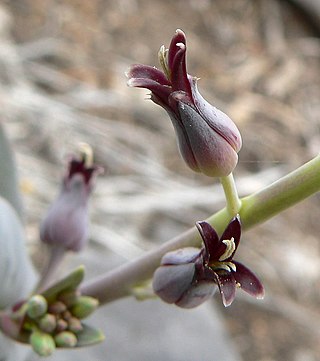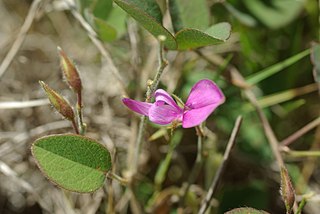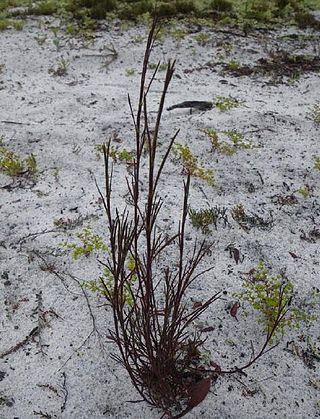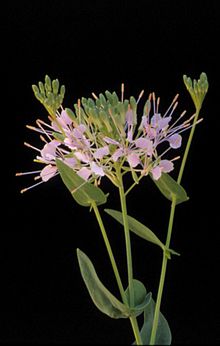
Warea carteri is a species of plant in the mustard family, Brassicaceae, known by the common names Carter's pinelandcress and Carter's mustard. It is an endangered, fire-dependent annual herb occurring in xeric, shrub-dominated habitats on the Lake Wales Ridge of central Florida in the United States.

Streptanthus cordatus is a species of flowering plant in the mustard family known by the common name heartleaf twistflower. It is native to the western United States, where it can be found in many types of sagebrush, woodland, and forest habitat. It is a perennial herb producing a branched or unbranched stem up to about a meter tall. It is often waxy in texture. The basal leaves are oval or spoon-shaped with bristle-toothed blades borne on rough-haired petioles. Leaves higher on the stem are oval to lance-shaped, up to 9 centimeters long with their bases usually clasping the stem. Flowers occur at intervals along the upper stem. Each has a calyx of sepals roughly a centimeter long which begin greenish yellow and mature purple. Four purple petals emerge from the tip of each calyx. The fruit is a thin, narrow silique which may reach 14 centimeters in length or longer.

Streptanthus diversifolius is a species of flowering plant in the mustard family known by the common name variableleaf jewelflower, or varied-leaved jewelflower. It is endemic to California, where it is limited to the Sierra Nevada foothills. It is a resident of woodlands and other foothill habitat. It is an annual herb producing a hairless, waxy stem up to a meter tall. The basal leaves are variable in shape and are often divided into narrow, threadlike segments. Leaves higher on the stem are also variable, having round to lance-shaped blades which clasp the stem at their bases. Flowers occur at intervals along the upper stem, with one or two leaflike bracts at the base of the raceme. Each flower has an urn-shaped calyx of keeled sepals about half a centimeter long and white, yellowish, or purple in color, sometimes with white edging. White, purple-veined petals emerge from the tip. The fruit is a thin, flat, curving silique which may be 8 or 9 centimeters in length.

Thelypodium stenopetalum is a rare species of flowering plant in the mustard family known by the common names slenderpetal thelypody, slender-petaled thelypodium and slender-petaled mustard. It is endemic to the San Bernardino Mountains of southern California, where it is known from only three or four extant occurrences in moist mountain meadows near Big Bear Lake. Its remaining habitat is considered seriously threatened and the plant is a federally listed endangered species in the United States.
Lepechinia rossii is a rare species of flowering plant in the mint family known by the common name Ross' pitcher sage.

Chionanthus pygmaeus is a rare species of flowering plant in the olive family known by the common name pygmy fringetree. It is endemic to Florida, where there are 46 known occurrences as of 2010. The plant is found in increasingly rare habitat in Central Florida that is being consumed for development, and some protected areas are not managed adequately. Most populations are small. It is a federally listed endangered species of the United States.

Asimina pulchella is a rare species of flowering plant in the custard apple family known by the common names beautiful pawpaw, royal false pawpaw, and white squirrel banana. It is a federal listed endangered species.

Asimina rugelii is a rare species of flowering plant in the custard apple family known by the common names Rugel's pawpaw, Rugel's false pawpaw, and yellow squirrel banana. It is endemic to Volusia County, Florida, in the United States, where there are fewer than 5000 plants remaining in severely fragmented habitat. The main threat to this species is habitat destruction and degradation. It was federally listed as an endangered species in 1986.

Galactia smallii is a rare species of flowering plant in the legume family known by the common name Small's milkpea. It is endemic to Florida, where it is known only from a few small patches of remaining habitat in Miami-Dade County. It is threatened by the destruction and inadequate management of its habitat. It was federally listed as an endangered species of the United States in 1985.

Harperocallis flava, known by the common name Harper's beauty, is a species endemic to parts of Florida in the United States, where it is known mainly from the Apalachicola National Forest in the Panhandle. It is seriously endangered and has been on the United States' endangered species list since 1979.

Hypericum cumulicola is a rare species of flowering plant in the family Hypericaceae known by the common name highlands scrub hypericum, or highlands scrub St. John's wort. It is endemic to Florida, where it is threatened by habitat loss and degradation. It is a federally listed endangered species of the United States.

Lupinus aridorum is a rare species of lupine known by the common name scrub lupine. It is endemic to Florida in the United States, where there were 10 known populations remaining in 2003. Fewer than 6000 individual plants were counted. It is threatened by the loss and degradation of its habitat. The scrub lupine is a federally listed endangered species of the United States.

Paronychia chartacea is a rare species of flowering plant in the family Caryophyllaceae known by the common names papery Whitlow-wort and paper nailwort. It is endemic to Florida in the United States. There are two subspecies of the plant; ssp. chartacea occurs in Central Florida, especially the Lake Wales Ridge, and ssp. minima is native to the Florida Panhandle. The two subspecies are geographically separated and do not occur together. Both are included on the federal Endangered Species List, on which the species is designated threatened.

Pinguicula ionantha is a rare species of flowering plant in the butterwort family known by the common names Godfrey's butterwort and violet butterwort. It is endemic to the US state of Florida, where it only occurs in the central Florida Panhandle. It is threatened by the loss of its habitat, and it is a federally listed threatened species of the United States.

Polygala lewtonii is a rare species of flowering plant in the milkwort family known by the common name Lewton's polygala, or Lewton's milkwort. It is endemic to Florida in the United States, where it is limited to the central ridge of the peninsula. There are about 49 occurrences of the plant remaining. Most occurrences contain very few plants. The species is threatened by the loss and degradation of its habitat. This is a federally listed endangered species of the United States.

Polygala smallii is a rare species of flowering plant in the milkwort family known by the common name tiny polygala, or tiny milkwort. It is endemic to Florida in the United States, where it is limited to the southeastern coast of the peninsula. The plant is now only known from eight sites, with most individuals located on one site in Miami-Dade County. The species is threatened by the loss of its habitat. This is a federally listed endangered species of the United States.

Polygonum basiramia is a rare species of flowering plant in the knotweed family known by the common names wireweed, hairy wireweed, purple wireweed, and Florida jointweed. It is endemic to Florida in the United States, where it is limited to the central ridges of the peninsula, including the Lake Wales Ridge. It is threatened by the loss and degradation of its habitat. It is a federally listed endangered species of the United States.

Xyris tennesseensis is a rare species of flowering plant in the family Xyridaceae known by the common name Tennessee yellow-eyed grass. It is native to a small section of the Southeastern United States, including parts of the states of Alabama, Georgia, and Tennessee. A federally listed endangered species, it is threatened by the loss and degradation of its habitat.

Parnassia caroliniana is a species of flowering plant in the Celastraceae known by the common name Carolina grass of Parnassus. It is native to the southeastern United States, where it occurs in North Carolina and South Carolina, with an isolated population in the Florida Panhandle.

Nemastylis floridana is a species of flowering plant in the family Iridaceae known by the common names Florida celestial, fallflowering pleatleaf, and fallflowering ixia. It is endemic to Florida in the United States, where it faces many threats to its existence, but so far remains viable.




















